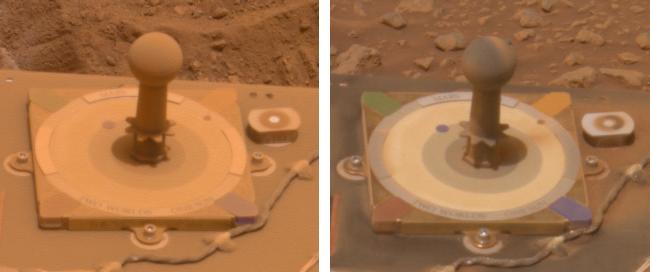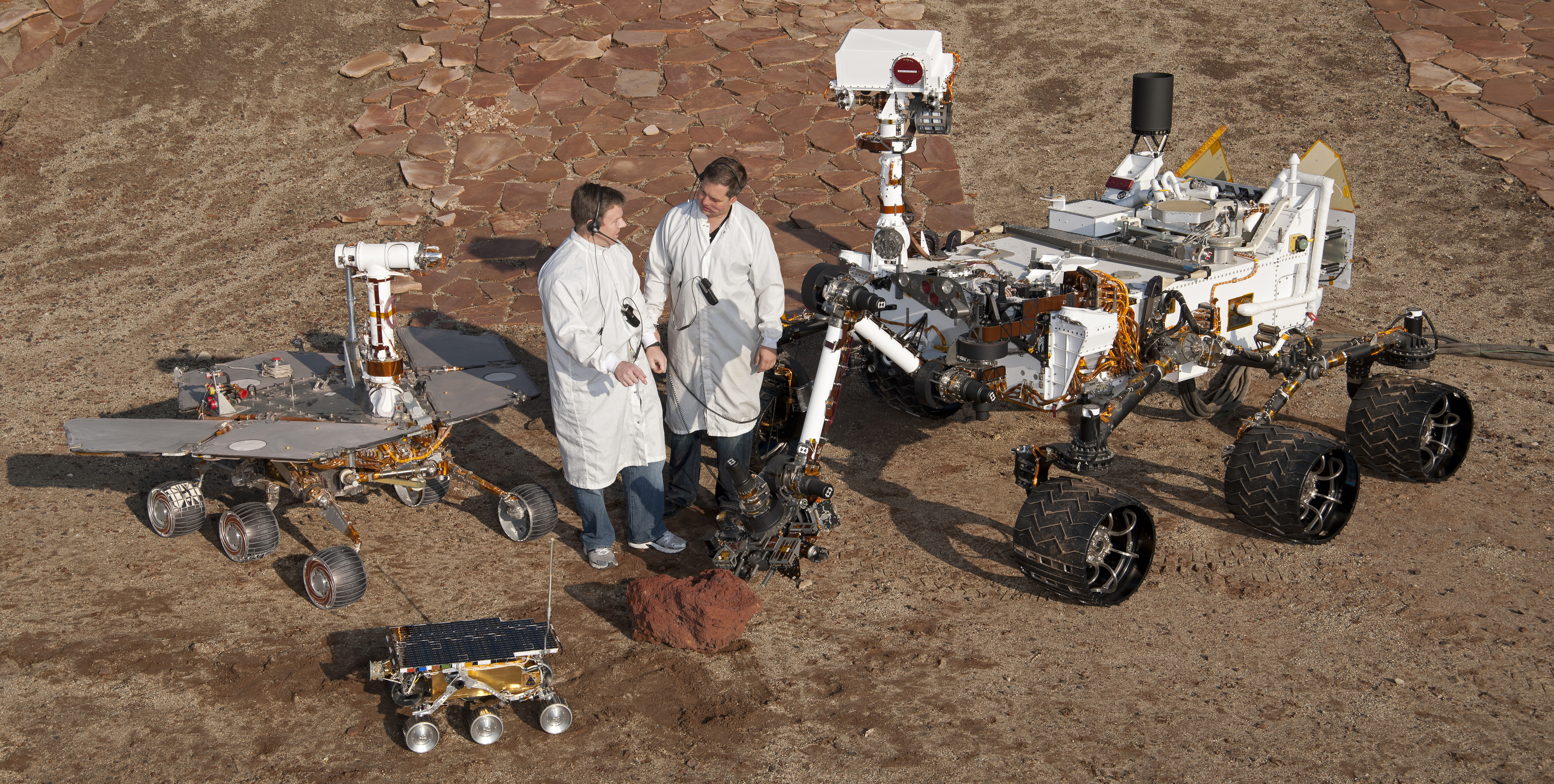|
Pancam
Each Pancam is one of two electronic stereo cameras on Mars Exploration Rovers ''Spirit'' and ''Opportunity''. It has a filter wheel assembly that enables it to view different wavelengths of light and the pair of Pancams are mounted beside two NavCams on the MER camera bar assembly. According to Cornell University it can work with Mini-TES to analyze surroundings. According to a paper about Mars by JPL, the Pancam system can achieve an angular resolution of 300 microradians, which is three times better than the human eye. It can observe 14 spectral bands, and with two side-by side cameras can generate stereoscopic views of Mars, supporting the creation of large Mars panoramas in excess of 10 Gbit uncompressed. ''Spirit'' rover took the highest resolution image ever taken on the surface of another planet up to that time when it landed in 2004. Optics The focal length of the camera is 43 mm with a field of view (FOV) of 16° x 16°. The two cameras are separated by 30& ... [...More Info...] [...Related Items...] OR: [Wikipedia] [Google] [Baidu] |
Mars Exploration Rovers
NASA's Mars Exploration Rover (MER) mission was a robotic space mission involving two Mars rovers, '' Spirit'' and '' Opportunity'', exploring the planet Mars. It began in 2003 with the launch of the two rovers to explore the Martian surface and geology; both landed on Mars at separate locations in January 2004. Both rovers far outlived their planned missions of 90 Martian solar days: MER-A ''Spirit'' was active until March 22, 2010, while MER-B ''Opportunity'' was active until June 10, 2018. Objectives The mission's scientific objective was to search for and characterize a wide range of rocks and soils that hold clues to past water activity on Mars. The mission is part of NASA's Mars Exploration Program, which includes three previous successful landers: the two Viking program landers in 1976 and Mars Pathfinder probe in 1997. The scientific objectives of the Mars Exploration Rover mission were to: *Search for and characterize a variety of rocks and soils that hold clues ... [...More Info...] [...Related Items...] OR: [Wikipedia] [Google] [Baidu] |
Mars Exploration Rover Mission
NASA's Mars Exploration Rover (MER) mission was a robotic space mission involving two Mars rovers, ''Spirit (rover), Spirit'' and ''Opportunity (rover), Opportunity'', exploring the planet Mars. It began in 2003 with the launch of the two rover (space exploration), rovers to explore the Martian surface and Geology of Mars, geology; both landed on Mars at separate locations in January 2004. Both rovers far outlived their planned missions of 90 Timekeeping on Mars#Sols, Martian solar days: MER-A ''Spirit'' was active until March 22, 2010, while MER-B ''Opportunity'' was active until June 10, 2018. Objectives The mission's scientific objective was to search for and characterize a wide range of rock (geology), rocks and soils that hold clues to past Water on Mars, water activity on Mars. The mission is part of NASA's Mars Exploration Program, which includes three previous successful landers: the two Viking program landers in 1976 and Mars Pathfinder probe in 1997. The scientific ... [...More Info...] [...Related Items...] OR: [Wikipedia] [Google] [Baidu] |
Spirit (rover)
''Spirit'', also known as MER-A (Mars Exploration Rover – A) or MER-2, is a Mars rover, Mars robotic rover, active from 2004 to 2010. ''Spirit'' was operational on Mars for Timekeeping on Mars#Sols, sols or 3.3 Martian years ( days; '). It was one of two rover (space exploration), rovers of NASA's Mars Exploration Rover Mission managed by the Jet Propulsion Laboratory (JPL). Spirit landed successfully within the impact crater Gusev (Martian crater), Gusev on Mars at 04:35 Ground UTC on January 4, 2004, three weeks before its twin, ''Opportunity (rover), Opportunity'' (MER-B), which landed on the other side of the planet. Its name was chosen through a Sofi Collis, NASA-sponsored student essay competition. The rover got stuck in a "sand trap" in late 2009 at an angle that hampered recharging of its batteries; its last communication with Earth was on March 22, 2010. The rover completed its planned 90-Martian day, sol mission (slightly less than 92.5 Earth days). Aided by cleani ... [...More Info...] [...Related Items...] OR: [Wikipedia] [Google] [Baidu] |
Opportunity (rover)
''Opportunity'', also known as MER-B (Mars Exploration Rover – B) or MER-1, and nicknamed Oppy, is a robotic rover that was active on Mars from 2004 until 2018. ''Opportunity'' was operational on Mars for sols ( on Earth). Launched on July 7, 2003, as part of NASA's Mars Exploration Rover program, it landed in Meridiani Planum on January 25, 2004, three weeks after its twin, '' Spirit'' (MER-A), touched down on the other side of the planet. With a planned 90- sol duration of activity (slightly less than 92.5 Earth days), ''Spirit'' functioned until it got stuck in 2009 and ceased communications in 2010, while ''Opportunity'' was able to stay operational for sols after landing, maintaining its power and key systems through continual recharging of its batteries using solar power, and hibernating during events such as dust storms to save power. This careful operation allowed ''Opportunity'' to operate for 57 times its designed lifespan, exceeding the initial plan by (in Ear ... [...More Info...] [...Related Items...] OR: [Wikipedia] [Google] [Baidu] |
Navcam
Navcam, short for navigational camera, is a type of camera found on certain robotic rovers or spacecraft used for navigation without interfering with scientific instruments. Navcams typically take wide angle photographs that are used to plan the next moves of the vehicle or object tracking. Overview The Mars ''Curiosity'' rover has two pairs of black and white navigation cameras mounted on the mast to support ground navigation. The cameras have a 45 degree angle of view and use visible light to capture stereoscopic 3-D imagery. These cameras, like those on the Mars Pathfinder missions support use of the ICER image compression format. European Space Agency ''Rosetta'' spacecraft used a single camera with 5 degree field of view and 12 bit 1024x1024px resolution allowing for visual tracking on each of spacecraft approaches to the asteroids and finally the comet. Gallery 20110406 PIA13809 D2011 0404 D036 cropped-full.jpg, ''Curiosity'' rover's mast with two navcams MER Pancam.J ... [...More Info...] [...Related Items...] OR: [Wikipedia] [Google] [Baidu] |
Hazcam
Hazcams (short for hazard avoidance cameras) are photographic cameras mounted on the front and rear of NASA's ''Spirit'', ''Opportunity'', ''Curiosity'' and ''Perseverance'' rover missions to Mars and on the lower front portion of Chinese ''Yutu'' rover mission to the Moon. Overview The ''Curiosity'' rover's hazcams are sensitive to visible light and return black and white images of resolution 1024 × 1024 pixels."Hazard Avoidance Camera (Hazcam)". PDS Geosciences Node. Retrieved September 4, 2019. These images are used by the rovers' internal computer to autonomously navigate around hazards. Due to their positioning on both sides of the rovers, simultaneous images taken by either both front or both rear cameras can be used to produce a [...More Info...] [...Related Items...] OR: [Wikipedia] [Google] [Baidu] |
Mini-TES
The Miniature Thermal Emission Spectrometer (Mini-TES) is an infrared spectrometer used for detecting the composition of a material (typically rocks) from a distance. By making its measurements in the thermal infrared part of the electromagnetic spectrum, it has the ability to penetrate through the dust coatings common to the Martian surface which is usually problematic for remote sensing observations. There is one on each of the two Mars Exploration Rovers. Development The Mini-TES was originally developed by Raytheon for the Department of Geological Sciences at Arizona State University. The Mini-TES is a miniaturized version of Raytheon's Mars Global Surveyor (MGS) TES, built by Arizona State University and Raytheon SAS’ Santa Barbara Remote Sensing. The MGS TES data helped scientists choose landing sites for the Spirit and Opportunity Mars explorer rovers. Martian soil The Mini-TES is used for identifying promising rocks and soils for closer examination, and to determine ... [...More Info...] [...Related Items...] OR: [Wikipedia] [Google] [Baidu] |
Rosalind Franklin (rover)
''Rosalind Franklin'', previously known as the ExoMars rover, is a planned robotic Mars rover, part of the international ExoMars programme led by the European Space Agency, European Space Agency (ESA). The rover is named after Rosalind Franklin, a British chemist and DNA research pioneer. The mission was scheduled to launch in July 2020 in cooperation with the Russian Roscosmos State Corporation, Roscosmos, and was later postponed to 2022. The Russian invasion of Ukraine has caused a delay of the programme, as the member states of the ESA voted to suspend the joint mission with Russia. in July 2022, ESA terminated its cooperation on the project with Russia. , the launch of the rover was not expected to occur before 2028 due to the need for a new non-Russian landing platform. In 2024, the mission received additional funding to restart and complete the mission. The award went to Thales Alenia Space and launch was scheduled for 2028. ESA also signed an agreement with NASA to procu ... [...More Info...] [...Related Items...] OR: [Wikipedia] [Google] [Baidu] |
List Of NASA Cameras On Spacecraft
NASA has operated several cameras on spacecraft over the course of its history. Apollo Program *Apollo TV camera *Hasselblad "Electric Camera" (modified 500 EL) with 70 mm film * Maurer Data Acquisition Camera (DAC) with 16 mm film * Nikon F with 35 mm film *Mapping (Metric) Camera (7.6 cm focal length) with 127 mm film, on Apollo 15, 16, and 17 (see Sherman Fairchild#Lunar photography) *Stellar Camera (7.6 cm focal length) with 35 mm film, on Apollo 15, 16, and 17 *Panoramic Camera (61 cm focal length) with 127 mm film, on Apollo 15, 16, and 17 Skylab Personal camera equipment:EP-107 Skylab: A GuidebookChapter 5/ref> *Television camera *16 mm film video camera *35 mm film camera *70 mm film camera Space Shuttle program * Space Shuttle#Ascent tracking, Space Shuttle booster cameras. * Space Shuttle External Tank camera * ''Columbia'' ** Shuttle Infrared Leeside Temperature Sensing experiment *Nikon NASA F4 Lunar missions * Pioneer program, 1958–1960 ** ... [...More Info...] [...Related Items...] OR: [Wikipedia] [Google] [Baidu] |
Curiosity Rover
''Curiosity'' is a car-sized Mars rover Space exploration, exploring Gale (crater), Gale crater and Mount Sharp on Mars as part of NASA's Mars Science Laboratory (MSL) mission. ''Curiosity'' was launched from Cape Canaveral Space Force Station, Cape Canaveral (CCAFS) on November 26, 2011, at 15:02:00 Coordinated Universal Time, UTC and landed on Aeolis Palus inside Gale crater on Mars on August 6, 2012, 05:17:57 UTC. The Bradbury Landing site was less than from the center of the rover's touchdown target after a journey. Mission #Goals and objectives, goals include an investigation of the Martian climate of Mars, climate and geology of Mars, geology, an assessment of whether the selected field site inside Gale has ever offered environmental science, environmental conditions favorable for Life on Mars, microbial life (including investigation of the Water on Mars, role of water), and planetary habitability studies in preparation for Human mission to Mars, human exploration. In ... [...More Info...] [...Related Items...] OR: [Wikipedia] [Google] [Baidu] |








